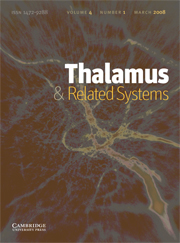Article contents
A firing-rate model of spike-frequency adaptation in sinusoidally-driven thalamocortical relay neurons
Published online by Cambridge University Press: 12 April 2006
Abstract
In a systematic study of thalamocortical relay neuron responses to sinusoidal current injection [J. Neurophysiol. 83 (1), 588], we found that the Fourier fundamental of tonic responses was regularly phase advanced during low temporal frequency stimulation (1/10 cycle at 0.1 Hz). We hypothesized that such phase advances of the Fourier fundamental response were due to a slow spike-frequency adaptation. Here we measure the time-dependence of the instantaneous firing rate during a current pulse protocol, confirm the presence of a slow spike-frequency adaptation, and quantify the adaptation time constant (0.6–2.0 s) and percentage adaptation of spike rate (40–60%). In light of these results, we augment a previously reported minimal integrate-and-fire-or-burst (IFB) neuron model with an adaptation current. When the parameters for this current are fit using a quantitative theory of spike-frequency adaptation [J. Neurophysiol. 79, 1549], the IFB model reproduces the experimentally observed phase advance of the Fourier fundamental response during sinusoidal current injection. Using fast-slow variable analysis, we develop a firing-rate reduction of the IFB model and perform parameter studies to investigate the dependence of the Fourier fundamental response (amplitude and phase) on the maximum conductance and recovery time constant for the adaptation current. Analytical calculations clarify the relationship between dc and ac measures of the suppression of response due to spike-frequency adaptation, show how the latter depends on stimulation frequency, and confirm the adaptation-induced phase advance of the Fourier fundamental observed in both experiment and simulation.
Information
- Type
- Research Article
- Information
- Copyright
- 2001 Elsevier Science Ltd
- 5
- Cited by

